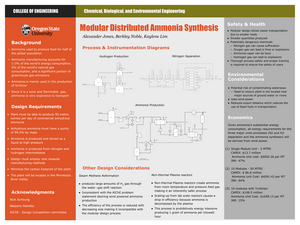
Ammonia is the base chemical used in fertilizer around the world. Its production currently commands 1-3% of the total energy consumption worldwide and 5% of the world’s total natural gas usage. Steps are being taken to modify the current ammonia production to model to a more sustainable system that uses only renewable energies. It is therefore the goal of the design to design and build a modular, renewable energy, ammonia plant within the upper midwest of the United States. This region is the largest cereal crop producer in North America, and as the largest agricultural crop producer, it requires the largest amount of ammonia. The plant built in the region, can take advantage of the close proximity demand and make use of the vast amounts of “stranded wind,” wind not currently used in renewable energy.
The plant will be split into ten 5 MTPD production modules, each consisting of upstream nitrogen and hydrogen gas separation processes, and a downstream Haber-Bosch ammonia synthesis process. The upstream processes sought to use only renewable wind energy in the form of membrane separation of nitrogen from compressed air, and electrolysis of water to produce ultrapure oxygen and hydrogen gas. The downstream ammonia made use of process intensification via magnesium chloride to increase reaction capabilities of the once limited Haber-Bosch process. Final design has ten 5 MTPD units within the plant and seven wind turbines to provide the necessary electricity. Economic analysis shows a total fixed capital investment of 108.5 million dollars, with a decent internal rate of return of 15%. However, to facilitate financial viability, the unit price for ammonia is a staggering $1658.13 per metric ton, nearly three times current market value. It is therefore recommended that other design options are explored as this design is not market competitive.
This project was done for the AIChE Student Design Competition.
